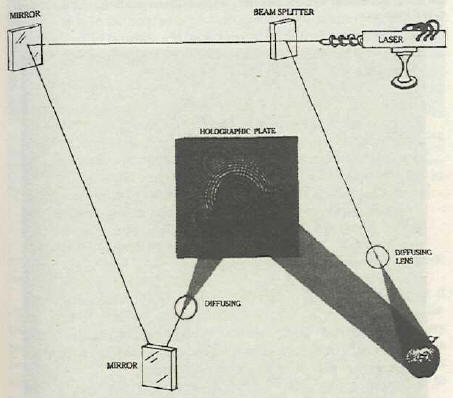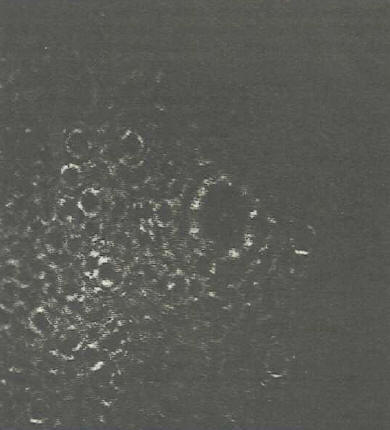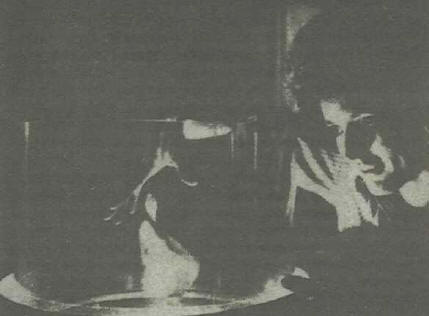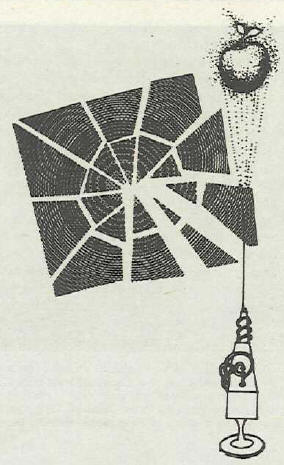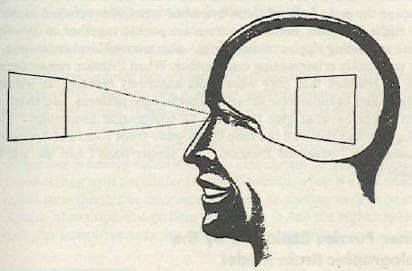|
PART I
The puzzle that first started Pribram on the road to formulating his holographic model was the question of how and where memories are stored in the brain.
In the early 1940s, when he first became interested in this mystery, it was generally believed that memories were localized in the brain. Each memory a person had, such as the memory of the last time you saw your grandmother, or the memory of the fragrance of a gardenia you sniffed when you were sixteen, was believed to have a specific location somewhere in the brain cells.
Such memory traces were called engrains, and although no one knew what an engram was made of - whether it was a neuron or perhaps even a special kind of molecule - most scientists were confident it was only a matter of time before one would be found. There were reasons for this confidence. Research conducted by Canadian neurosurgeon Wilder Penfield in the 1920s had offered convincing evidence that specific memories did have specific locations in the brain. One of the most unusual features of the brain is that the object itself doesn’t sense pain directly.
As long as the scalp and skull have been deadened with a local anesthetic, surgery can be performed on the brain of a fully conscious person without causing any pain.
One man suddenly relived a conversation he had had with friends in South Africa; a boy heard his mother talking on the telephone and after several touches from Penfield’s electrode was able to repeat her entire conversation; a woman found herself in her kitchen and could hear her son playing outside. Even when Penfield tried to mislead his patients by telling them he was stimulating a different area when he was not, he found that when he touched the same spot it always evoked the same memory.
From his research Penfield concluded that everything we have ever experienced is recorded in our brain, from every stranger’s face we have glanced at in a crowd to every spider web we gazed at as a child. He reasoned that this was why memories of so many insignificant events kept cropping up in his sampling. If our memory is a complete record of even the most mundane of our day-to-day experiences, it is reasonable to assume that dipping randomly into such a massive chronicle would produce a good deal of trifling information.
For over thirty years Lashley had been involved in his own ongoing search for the elusive mechanisms responsible for memory, and there Pribram was able to witness the fruits of Lashley’s labors firsthand. What was startling was that not only had Lashley failed to produce any evidence of the en-gram, but his research actually seemed to pull the rug out from under all of Penfield’s findings.
Often the rats’ motor skills were impaired and they stumbled clumsily through the mazes, but even with massive portions of their brains removed, their memories remained stubbornly intact.
In 1948 Pribram was offered a position at Yale, and before leaving he helped write up thirty years of Lashley’s monumental research.
After all, patients who had had portions of their brains removed for medical reasons never suffered the loss of specific memories. Removal of a large section of the brain might cause a patient’s memory to become generally hazy, but no one ever came out of surgery with any selective memory loss.
Similarly, individuals who had received head injuries in car collisions and other accidents never forgot half of their family, or half of a novel they had read. Even removal of sections of the temporal lobes, the area of the brain that had figured so prominently in Penfield’s research, didn’t create any gaps in a person’s memories.
However, if you reach out and try to touch it, your hand will waft right through it and you will discover there is really nothing there (see fig. 3).
FIGURE 1. A hologram is produced when a single laser light is split into two separate beaniE. The first beam is bounced off the object to be photographed, in this case an apple.
Then the second beam
is allowed to collide with the reflected light of the first, and the
resulting interference pattern is recorded on film.
Three-dimensionality is not the only remarkable aspect of holograms. If a piece of holographic film containing the image of an apple is cut in half and then illuminated by a laser, each half will still be found to contain the entire image of the apple!
Even if the halves are divided again and then again, an entire apple can still be reconstructed from each small portion of the film (although the images will get hazier as the portions get smaller).
FIGURE 2. A piece of holographic film containing an encoded image. To the naked eye the image on the film looks nothing like the object photographed and is composed of irregular ripples known as interference patterns. However, when the film is illuminated with another laser,
a three-dimensional
image of the original object reappears.
The three-dimensionality of a hologram is often so eerily convincing that you can actually walk around it and view it from different angles. But if you reach out and try to touch it, your hand will waft right through it [”Celeste Undressed.” Holographic stereogram by Peter Claudius, 1978. Photograph by Brad Cantos, collection of The Museum of Holography]
Unlike normal photographs, every small fragment of a piece of holographic film contains all the information recorded in the whole (see fig. 4).*
* It should be noted that this astounding trait is common only to pieces of holographic film whose images are invisible to the naked eye. If you buy a piece of holographic film (or an object containing a piece of holographic film) in a store and can see a three-dimensional image in it without any special kind of illumination, do not cut it in half. You will only end UP with pieces of the original image.
FIGURE 4. Unlike normal photographs, every portion of a piece of holographic film contains all of the information of the whole. Thus if a holographic plate is broken into fragments, each piece can still be used to reconstruct the entire image.
Another of Lashley’s discoveries was that the visual centers of the brain were also surprisingly resistant to surgical excision. Even after removing as much as 90 percent of a rat’s visual cortex (the part of the brain that receives and interprets what the eye sees), he found it could still perform tasks requiring complex visual skills.
Similarly, research conducted by Pribram
revealed that as much as 98 percent (the part of the brain that
receives and interprets what the eye sees), he found it
Such a situation was tantamount to believing that a movie audience could still enjoy a motion picture even after 90 percent of the movie screen was missing, and his experiments presented once again a serious challenge to the standard understanding of how vision works. According to the leading theory of the day, there was a one-to-one correspondence between the image the eye sees and the way that image is represented in the brain. In other words, when we look at a square, it was believed the electrical activity in our visual cortex also possesses the form of a square (see fig. 5).
He wrote of his findings,
FIGURE 5. Vision theorists once believed there was a one-to-one correspondence between an image the eye sees and how that image is represented in the brain.
Pribram discovered
this is not true.
Once again the resistance the visual cortex displayed toward surgical excision suggested that, like memory, vision was also distributed, and after Pribram became aware of holography he began to wonder if it, too, was holographic.
The “whole in every part” nature of a hologram certainly seemed to explain how so much of the visual cortex could be removed without affecting the ability to perform visual tasks. If the brain was processing images by employing some kind of internal hologram, even a very small piece of the hologram could still reconstruct the whole of what the eyes were seeing. It also explained the lack of any one-to-one correspondence between the external world and the brain’s electrical activity.
Again, if the brain was using holographic principles to process visual information, there would be no more one-to-one correspondence between electrical activity and images seen than there was between the meaningless swirl of interference patterns on a piece of holographic film and the image the film encoded.
Neurons possess branches like little trees, and when an electrical message reaches the end of one of these branches it radiates outward as does the ripple in a pond. Because neurons are packed together so densely, these expanding ripples of electricity - also a wavelike phenomenon - are constantly crisscrossing one another.
When Pribram remembered this he realized that they were most assuredly creating an almost endless and kaleidoscopic array of interference patterns, and these in turn might be what give the brain its holographic properties.
As he did, and as other researchers became aware of his theory, it was quickly realized that the distributed nature of memory and vision is not the only neurophysiologies! puzzle the holographic model can explain.
The holographic idea offers a further analogy for the associative tendencies of memory.
This is illustrated by yet another kind of holographic recording technique.
First, the light of a single laser beam is bounced off two objects simultaneously, say an easy chair and a smoking pipe. The light bounced off each object is then allowed to collide, and the resulting interference pattern is captured on film.
Then, whenever the easy chair is illuminated with laser light and the light that reflects off the easy chair is passed through the film, a three-dimensional image of the pipe will appear. Conversely, whenever the same is done with the pipe, a hologram of the easy chair appears.
So, if our brains function holographically, a similar process may be responsible for the way certain objects evoke specific memories from our past.
At first glance our ability to recognize familiar things may not seem so unusual, but brain researchers have long realized it is quite a complex ability.
For example, the absolute certainty we feel when we spot a familiar face in a crowd of several hundred people is not just a subjective emotion, but appears to be caused by an extremely fast and reliable form of information processing in our brain.
* Van
Heerden, a researcher at the Polaroid Research Laboratories m
Cambridge, Massachusetts, actually proposed his own version of a
holographic theory of memory in 1963, but his work went relatively
unnoticed. If a second object, similar but not identical to the first, is bathed in laser light and the light is bounced off the mirror and onto the film after it has been developed, a bright point of light will appear on the film. The brighter and sharper the point of light, the greater the degree of similarity between the first and second objects. If the two objects are completely dissimilar, no point of light will appear. By placing a light-sensitive photocell behind the holographic film, one can actually use the setup as a mechanical recognition system.7
The technique is so sensitive that even the pressure of a finger on a block of granite shows up immediately, and the process has been found to have practical applications in the materials-testing industry.8
Typically, individuals with photographic memories will spend a few moments scanning the scene they wish to memorize.
When they want to see the scene again, they “project” a mental image of it, either with their eyes closed or as they gaze at a blank wall or screen. In a study of one such individual, a Harvard art history professor named Elizabeth, Pollen and Tractenberg found that the mental images she projected were so real to her that when she read an image of a page from Goethe’s Faust her eyes moved as if she were reading a real page.
Conversely, perhaps most of us have memories that are much less vivid because our access is limited to smaller regions of the memory holograms.9
As you sit reading this book, take a moment and trace your first name in the air with your left elbow. You will probably discover that this is a relatively easy thing to do, and yet in all likelihood it is something you have never done before.
It may not seem a surprising ability to you, but in the classic view that various areas of the brain (such as the area controlling the movements of the elbow) are “hard-wired,” or able to perform tasks only after repetitive learning has caused the proper neural connections to become established between brain cells, this is something of a puzzle. Pribram points out that the problem becomes much more tractable if the brain were to convert all of its memories, including memories of learned abilities such as writing, into a language of interfering wave forms. Such a brain would be much more flexible and could shift its stored information around with the same ease that a skilled pianist transposes a song from one musical key to another.
Again, once the brain has memorized a face (or any other object or scene) and converted it into a language of wave forms, it can, in a sense, tumble this internal hologram around and examine it from any perspective it wants.
But it is not so clear how our brains enable us to distinguish between the two. For example, Pribram points out that when we look at a person, the image of the person is really on the surface of our retinas. Yet we do not perceive the person as being on our retinas. We perceive them as being in the “world-out-there.” Similarly, when we stub our toe we experience the pain in our toe.
But the pain is not really in our toe. It is actually a neurophysiological process taking place somewhere in our brain. How then is our brain able to take the multitude of neurophysiological processes that manifest as our experience, all of which are internal, and fool us into thinking that some are internal and some are located beyond the confines of our gray matter?
This is because a hologram is a virtual image, an image that appears to be where it is not, and possesses no more extension in space than does the three-dimensional image you see of yourself when you look in a mirror. Just as the image in the mirror is located in the silvering on the mirror’s back surface, the actual location of a hologram is always in the photographic emulsion on the surface of the film recording it.
By doing so he discovered that he could
make his test subjects experience the sensation that a point source
of vibration was jumping from one knee to the other. He found that
he could even make his subjects feel the point source of vibration
in the space between their knees. In short, he demonstrated that
humans have the ability to seemingly experience sensation in spatial
locations where they have absolutely no sense receptors.10 Pribram believes that Bekesy’s work is compatible with the holographic view and sheds additional light on how interfering wave fronts - or in Bekesy’s case, interfering sources of physical vibration - enable the brain to localize some of its experiences beyond the physical boundaries of the body. He feels this process might also explain the phantom limb phenomenon, or the sensation experienced by some amputees that a missing arm or leg is still present.
Such individuals often feel eerily realistic cramps, pains, and tinglings in these phantom appendages, but maybe what they are experiencing is the holographic memory of the limb that is still recorded in the interference patterns in their brains.
One researcher who provided such evidence was Indiana University biologist Paul Pietsch. Intriguingly, Pietsch began as an ardent disbeliever in Pribram’s theory. He was especially skeptical of Pribram’s claim that memories do not possess any specific location in the brain.
He writes about this experience as well
as giving detailed accounts of his experiments in his insightful
book Skujjtebrain.
While the theories that enabled the development of the hologram were first formulated in 1947 by Dennis Gabor (who later won a Nobel Prize for his efforts), in the late 1960s and early 1970s Pribram’s theory received even more persuasive experimental support.
When Gabor first conceived the idea of holography he wasn’t thinking about lasers.
His goal was to improve the electron microscope, then a primitive and imperfect device. His approach was a mathematical one, and the mathematics he used was a type of calculus invented by an eighteenth-century Frenchman named Jean E. J. Fourier.
They also enabled him to devise a way of converting those interference patterns back into an image of the original object. In fact the special whole in every part of a hologram is one of the by-products that occurs when an image or pattern is translated into the Fourier language of wave forms.
Only one
conclusion could be drawn. The brain was using Fourier
mathematics - the same mathematics holography employed - to convert
visual images into the Fourier language of wave forms.12 The DeValoises’ discovery was subsequently confirmed by numerous other laboratories around the world, and although it did not provide absolute proof the brain was a hologram, it supplied enough evidence to convince Pribram his theory was correct. Spurred on by the idea that the visual cortex was responding not to patterns but to the frequencies of various wave forms, he began to reassess the role frequency played in the other senses.
Interestingly, Bekesy also discovered that the mathematical equations that enabled him to predict how his subjects would respond to various frequencies of vibration were also of the Fourier genre.
FIGURE 6. Russian researcher Nikolai Bernstein painted white dots on dancers and filmed them dancing against a black background. When he converted their movements into a language of wave forms, he discovered they could be analyzed using Fourier mathematics, the same mathematics Gabor used to invent the hologram.
In the 1930s Bernstein dressed people in black leotards and painted white dots on their elbows, knees, and other joints.
Then he placed them against black backgrounds and took movies of them doing various physical activities such as dancing, walking, jumping, hammering, and typing.
For instance, we do not learn to ride a bicycle by painstakingly memorizing every tiny feature of the process. We learn by grasping the whole flowing movement. The fluid wholeness that typifies how we learn so many physical activities is difficult to explain if our brains are storing information in a bit-by-bit manner.
But it becomes much easier to understand if the brain is Fourier-analyzing such tasks and absorbing them as a whole.
Part of the problem is that there are many popular theories of how the brain works and there is evidence to support them all.
Some researchers believe the distributed nature of memory can be explained by the ebb and flow of various brain chemicals. Others hold that electrical fluctuations among large groups of neurons can account for memory and learning. Each school of thought has its ardent supporters, and it is probably safe to say that most scientists remain unpersuaded by Pribram’s arguments.
For example, neuropsychologist Frank Wood of the Bowman Gray School of Medicine in Winston-Salem, North Carolina, feels that,
Pribram is puzzled by statements such as
Wood’s and counters by noting that he currently has a book in press
with well over 500 references to such data.
Dr. Larry Dossey, former chief of staff at Medical City Dallas Hospital, admits that Pribram’s theory challenges many long-held assumptions about the brain, but points out that,
Neurologist Richard Restak, author of the PBS series The Brain, shares Dossey’s opinion.
He notes that in spite of overwhelming evidence that human abilities are holistically dispersed throughout the brain, most researchers continue to cling to the idea that function can be located in the brain in the same way that cities can be located on a map. Restak believes that theories based on this premise are not only “oversimplistic,” but actually function as “conceptual straitjackets” that keep us from recognizing the brain’s true complexities.16
He feels that “a hologram is not only
possible but, at this moment, represents probably our best ‘model’
for brain functioning.”
As for Pribram, by the 1970s enough evidence had accumulated to convince him his theory was correct.
In addition, he had taken his ideas into the laboratory and discovered that single neurons in the motor cortex respond selectively to a limited bandwidth of frequencies, a finding that further supported his conclusions.
The question that began to bother him was,
The dilemma posed by this question is analogous to taking a Polaroid picture of a group of people sitting around a table and, after the picture develops, finding that, instead of people, there are only blurry clouds of interference patterns positioned around the table.
In both cases one could rightfully ask,
Pribram realized that if the holographic brain model was taken to its logical conclusions, it opened the door on the possibility that objective reality - the world of coffee cups, mountain vistas, elm trees, and table lamps - might not even exist, or at least not exist in the way we believe it exists.
Was it possible, he wondered, that what the mystics had been saying for centuries was true, reality was maya, an illusion, and what was out there was really a vast, resonating symphony of wave forms, a “frequency domain” that was transformed into the world as we know it only after it entered our senses?
When Pribram did he was electrified.
He not only found the answer to his question, but also discovered that according to Bohm, the entire universe was a hologram.
|
